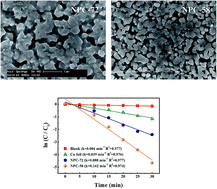Fabrication of nanoporous copper with tunable ligaments and promising sonocatalytic performance by dealloying Cu–Y metallic glasses†
Abstract
Nanoporous copper (NPC) with tunable ligaments was prepared by dealloying Cu–Y binary amorphous ribbons in sulfuric acid (H2SO4) solution. The ligament size of the NPC sample synthesized by dealloying Cu58Y42 metallic glasses (237 nm) is much smaller than the one by dealloying Cu72Y28 (406 nm). This result reveals that the microstructure of NPC can be strongly influenced by the alloy composition of precursor alloys. Then, NPC with different microstructures were applied in the sono-catalytic degradation of methyl orange (MO) dye. NPC produced by dealloying Cu58Y42 metallic glasses displayed superior sonocatalytic activity compared to commercial copper foil and the sample by dealloying Cu72Y28. The mechanism of the sono-Fenton-like process of NPC can be explained by being due to a combination of Cu ligament, H2O2 and ultrasound. In addition, the influence of the dealloying conditions (acid concentration, temperature and leaching time) on the ligament size of NPC was evaluated comprehensively, which could provide meaningful insight for further fabricating NPC with more desirable morphology and higher catalytic activity.



 Please wait while we load your content...
Please wait while we load your content...